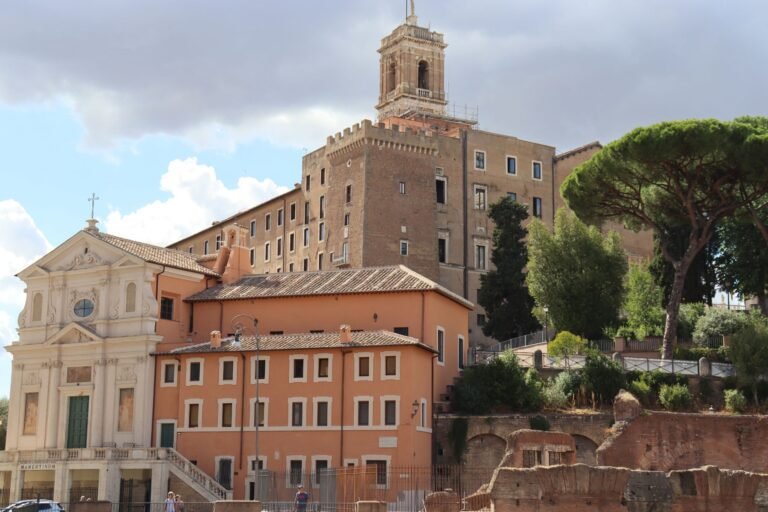How to Spend 48 Hours in Rome: Iconic Sights and Hidden Gems
If you only have 48 hours in Rome, you might be wondering: can I really experience the magic of the Eternal City in just two days?
And the answer to that is yes… but only if you do it right.
So in this ultimate Rome itinerary, I’ll show you exactly how to make the most of Rome’s ancient charm, all in just one unforgettable weekend!
In my opinion, a trip to Rome shouldn’t be treated as just another checklist of things to see. Exploring the city is, in itself, a feeling. It’s making a wish at the Trevi Fountain before the crowds arrive, eating gelato at an out-of-the-way gelateria, or taking in the view from Palatine Hill as the day winds down.
With only 48 hours, you won’t see everything Italy’s capital city has to offer – but if you follow this itinerary, you’ll see enough to have an unforgettable weekend in Rome!
And what makes this guide different? Well, I’ve written this two-day journey from my real experiences – the hits, the hidden gems, the little moments that made this trip so special.
You’ll find the major must-sees, of course, but you’ll also find off-the-beaten-path moments, practical travel advice and honest tips to help you make the most of your trip without overwhelm.
So whether it’s your first trip or your fifth, this itinerary is your cheat code for feeling like you really experienced Rome – and didn’t just rush through it.
Disclaimer: Some of the links on this blog are affiliate links. That means if you click on one and make a purchase, I may earn a small commission – at no extra cost to you. I only recommend products, places and services I genuinely love and use on my own solo travels. Thank you for supporting my adventures so I can continue to provide free content on this blog! 💛
48 Hours in Rome At A Glance
- Best Time to Visit | April–May or September–October, for mild weather with fewer crowds.
- Ideal Trip Length | 2–3 days
- Best For | Solo travellers, first-timers, history lovers, a romantic break
- Language | Italian (but English is very widely spoken!)
- Currency | Euro (€)
- Solo Travel Safety Score | 8.5/10 (tips below!)
- Best Area to Stay | Centro Storico or Trastevere
- Walkability | Very high – so be sure to bring comfy shoes!
Is 48 Hours Enough Time to Visit Rome?
The answer to this commonly asked question is not a simple one.
Because, while of course it would be great if you had more time to explore this beautiful city, 48 hours in Rome can absolutely be enough time – if you embrace your trip with the right mindset.
And while you won’t see everything (and you’re not meant to), two days is the perfect amount of time to experience the very best the eternal city has to offer.
Katie’s Top Tip: Choose quality over quantity if you’ve only got 48 hours in Rome. Focus on a few incredible places each day, not everything all at once.
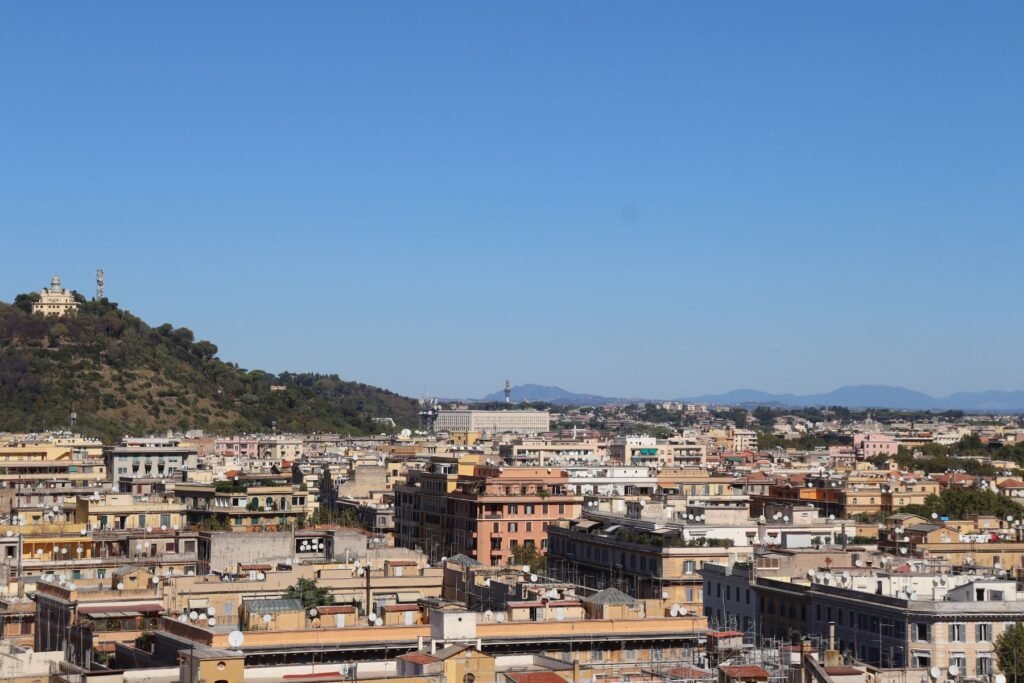
Top 10 Things To Do in Rome
Before we get into the 48 hours in Rome itinerary, here are the top 10 must-see things to do in Rome, that we will be covering during your perfect weekend in the Eternal City:
1. Marvel at The Colosseum
No trip to the Eternal City of Rome would be complete without visiting the Colosseum!
And while you may be tempted to treat it as just another bucket list worthy photo stop during your 48 hours in Rome, I whole-heartedly recommend that you take the time to go inside and allow yourself to get lost in the stories.
The included audio guide or taking a tour with a dedicated guide (I recommend this one!) will really bring these stories and the incredible history of this ancient amphitheatre to life and make your visit unforgettable.
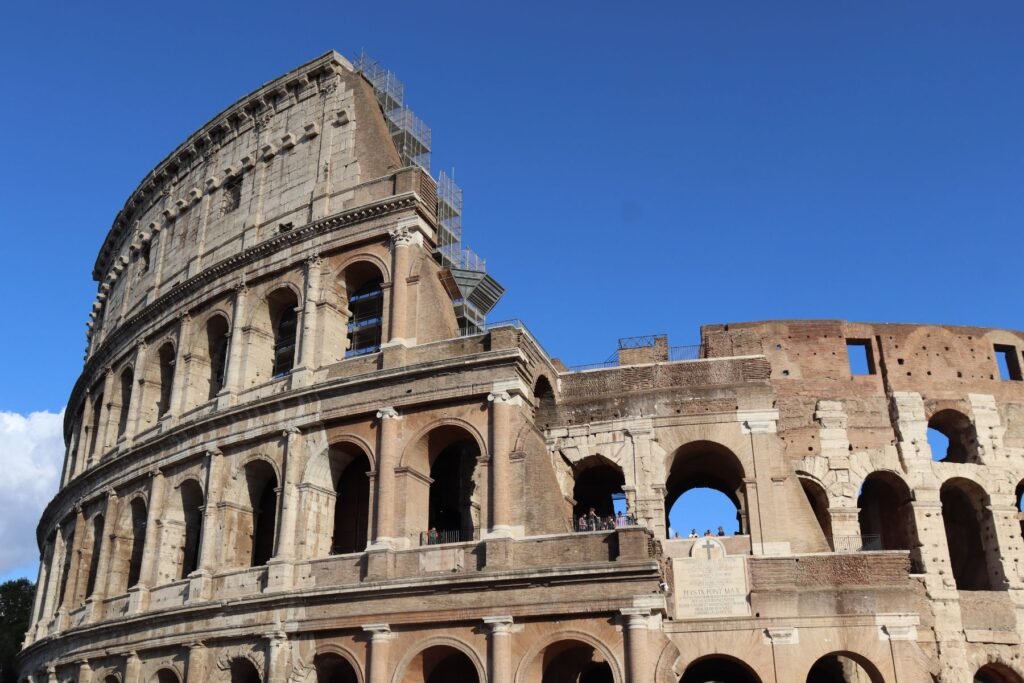
2. Walk in the Footsteps of The Romans at The Roman Forum
If you have already purchased a ticket to visit the Colosseum, entrance to the Roman Forum is also included.
You could spend hours wandering around the ruins, picturing life as it would’ve been back then, walking in the footsteps of the Romans who have come before us!
And for a panoramic view of the Forum and Rome city, don’t miss walking up to the terraces of Campidoglio. It’s a short, steep climb, but well worth the effort for a view that will take your breath away!
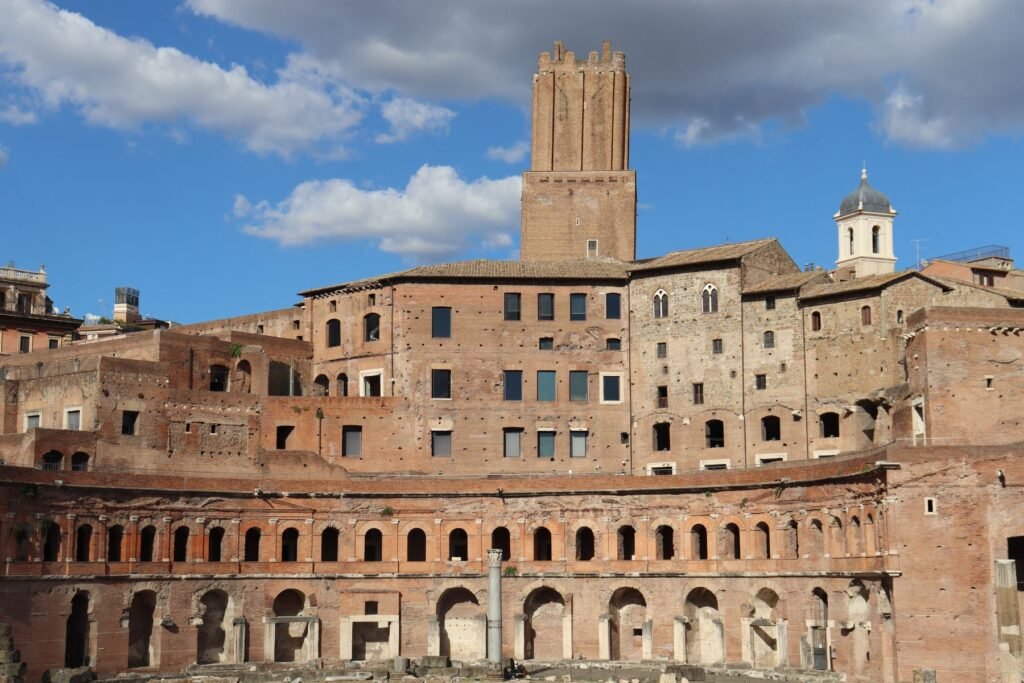
3. Eat Gelato
And I don’t mean just any gelato – authentic gelato!
But where do you find authentic gelato in Rome, a city that thrives on being touristy?
My favourite gelato can be found at Gelateria La Romana (and I recommend classic chocolate – always! Or one of the more fruity flavours like strawberry or mango.)
This gelateria is located a 14 minute walk from Castel Sant Angelo or a 30 minute walk from Vatican City, but it is well worth the detour!
4. … And Also Eat Pizza or Pasta (or both – of course!)
Can you even say you’ve been to Rome if you don’t try either pasta or pizza (or preferably both)?!
However, I will say that I did struggle with eating alone in Rome. It is unfortunately common to discover that restaurants aren’t so willing to seat tables for one, as they will earn more money from a couple occupying that table – so it is important to do your research and read reviews.
I have yet to find my perfect Rome restaurant that I can wholeheartedly recommend (so please hit me up in the comments below if you know a spot!) however I will say that you get a good feel for the local restaurants by simply walking the streets just off the main squares e.g. Piazza Navona.
These local trattoria’s are much more likely to be cosy and welcoming than the impersonal restaurants located by tourist destinations.
5. Climb Up The Spanish Steps
The view from the top of the Spanish Steps is stunning and well worth the climb, but I would recommend visiting early in the morning before the crowds and tourist groups arrive.
Trust me, it does not feel so magical when you’re surrounded by selfie sticks and being jostled for position!
It is also important to know that sitting on the steps is now discouraged and you can be fined if you do so.
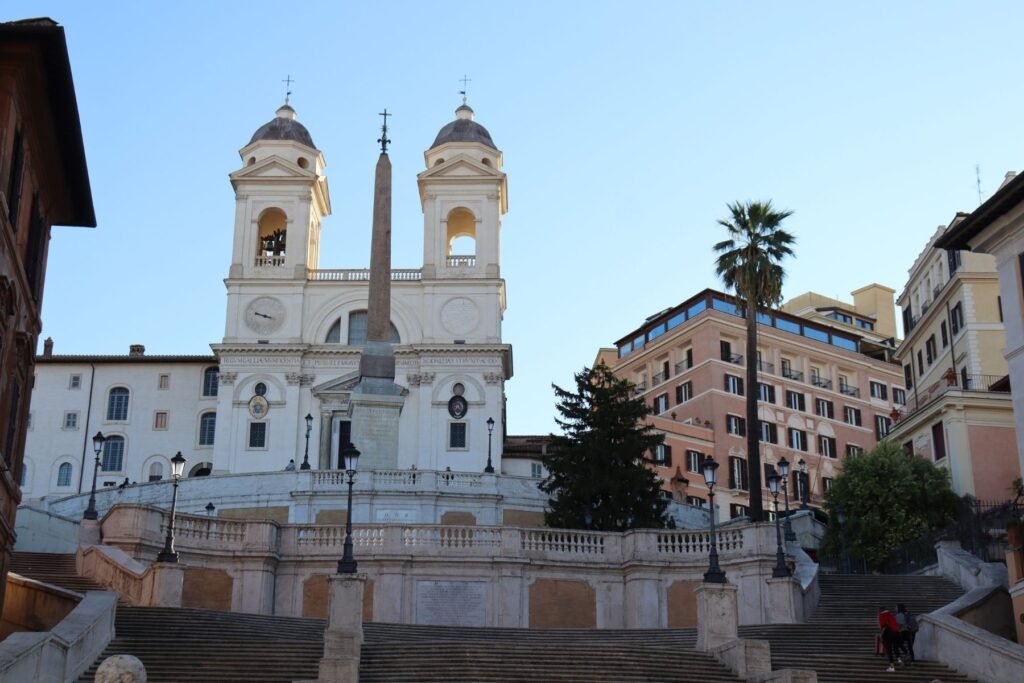
6. Make A Wish At The Trevi Fountain
Is Trevi Fountain overrated? Possibly.
And do I think it beats anything else on this list of must-see attractions in Rome? No.
But is it worth a mention (and a visit)? Definitely yes!
The Trevi Fountain is an iconic piece of Rome’s history, but it is also one of the busiest (and smallest), of the city’s attractions.
And busy + small = crowded, even in the shoulder seasons.
To have a positive experience at the Trevi Fountain, I would recommend arriving as early in the day as you can, before most of the tourists are awake.
Don’t get me wrong, you will never find the Trevi Fountain deserted, but as someone who has made the mistake of walking by at 3pm peak time (never again!) I can tell you that it is well worth the early alarm call to see it in the morning!
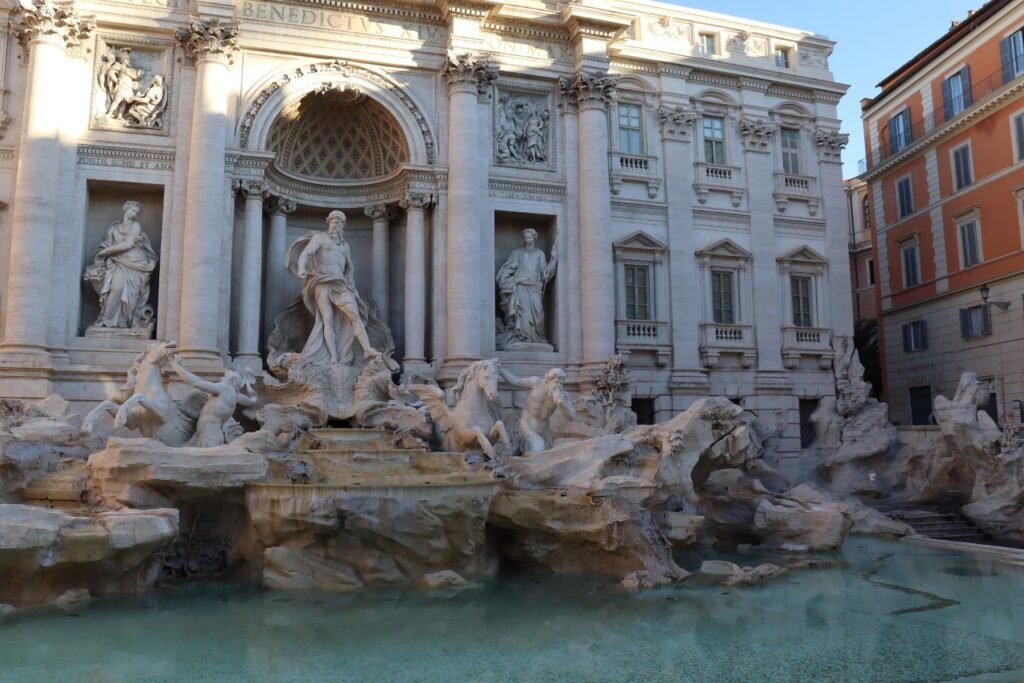
7. Get Lost in the History of the Vatican Museums
The Vatican Museums feel like a city in their own right – to say they are sprawling with corridor after corridor of artwork, statues and history would be an understatement!
(Don’t forget good walking shoes for this one!)
You can easily spend most of the day wandering the Vatican Museums – and you would probably still miss things. The area and the exhibits are vast.
But if you are into art and Catholic history – and you want to see the iconic Sistine Chapel (more on that later!) it is well worth a visit.
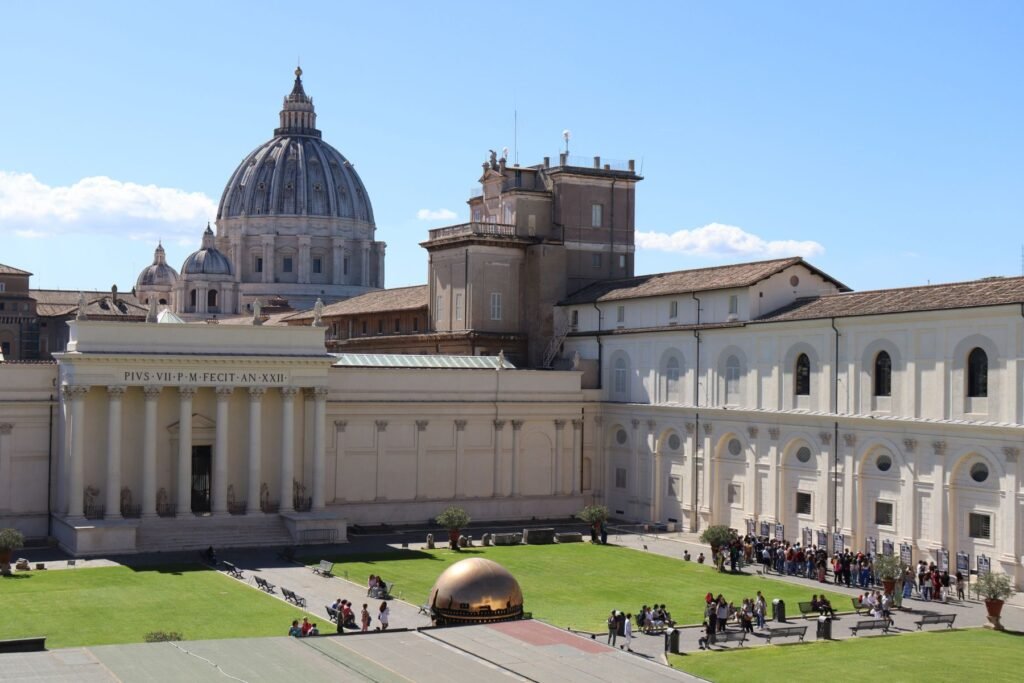
8. … Before Enjoying Some Quiet Reflection in the Vatican Gardens
Once you’ve finished exploring the Vatican Museums, you’ll definitely want to find a quiet space to relax, rest your feet and reflect.
Even if you are not religious (or if you share a different religion), there is something magical about visiting Vatican City.
You almost feel part of its history just by being there – and the gardens are my favourite part!
Katie’s Top Tip: Send a postcard to your loved ones from inside Vatican City to get the Vatican postal mark! The Vatican is also the most efficient and reliable place to send postcards from in Rome.
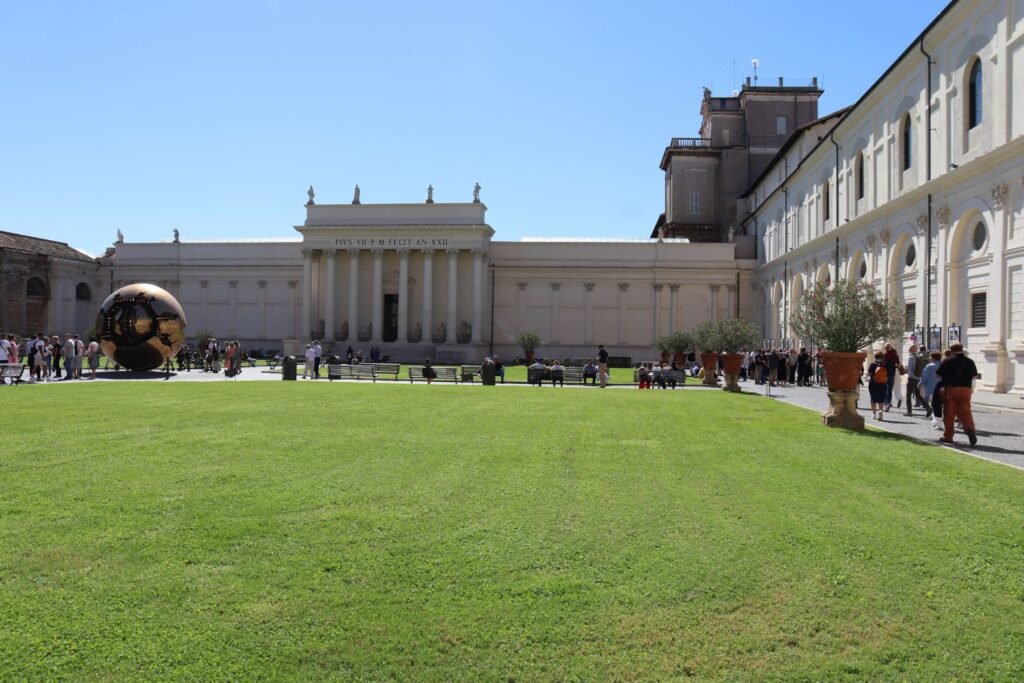
9. See the Sistine Chapel
No visit to Vatican City would be complete without seeing the famous Sistine Chapel.
The chapel is included as part of the ticket to see the Vatican Museums and you can’t visit one without the other.
The Sistine Chapel, while stunning, is very touristy – and you’ll never be free from crowds during your visit.
It is also forbidden to take photos inside the chapel (although the majority of tourists seemed to be ignoring that rule when I was in there). But don’t let that put you off.
It truly is one of a kind and a definite Vatican City must-see!
10 Watch the World Go By in Piazza Navona
Piazza Navona is one of Rome’s most beautiful (and most popular) squares.
There are cafes and restaurants lining its sides, although these are extremely busy and expensive, so if you’re not in the mood to splurge, try to snag one of the few benches in the square.
One of my favourite memories from my last visit to Rome is sitting in the square, watching the world go by, drinking a can of lemon Schweppes I bought from a nearby supermarket!
Almost always, it truly is the small moments that you remember.
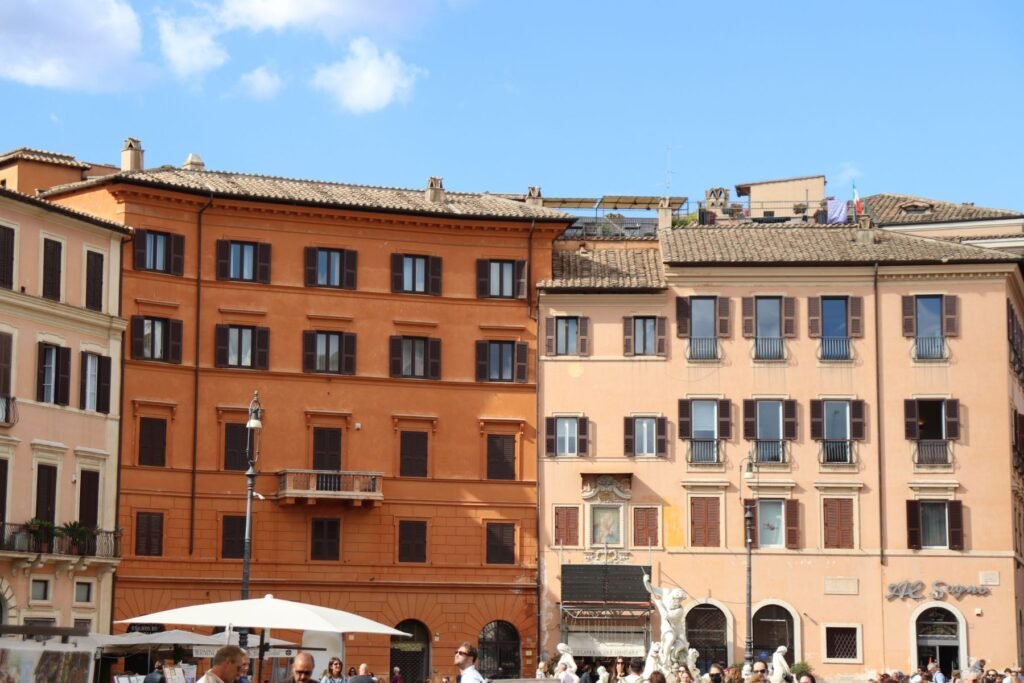
Your Perfect 48 Hours in Rome Itinerary
So now you know what to expect, lets get into how to combine these 10 top things to do in Rome into a perfect (non overwhelming) 48 hour itinerary:
Day 1 – Ancient Wonders & Iconic Rome
To me, my first moments in Rome felt like stepping onto a living, breathing movie set!
As you walk the ancient Roman streets and see the Colosseum for the first time, it is impossible not to feel in awe of this beautiful place and its history.
But, like any big city, your first visit (in particular, your first 24 hours), can feel overwhelming to say the least. So I hope this itinerary can help you with that, in some small way.
It is designed so that you can “see it all” without rushing from one photo spot to the next, never truly seeing, experiencing or feeling the place. Let’s get into it!
Morning: The Colosseum
My top tip for 48 hours in Rome is getting up early to make the most of your time in the city, however I know that isn’t always possible.
For example, the last time I visited the city, I was arriving from Florence at around 10:30am before diving straight into this exact itinerary. So for that reason, I have left your first morning with just one attraction – the colosseum!
(But for my fellow early birds with a full morning to spare, don’t worry – I’ve got you! I will also suggest a few other spots near the Colosseum in just a second).
The Colosseum is Rome’s most iconic ancient landmark.
Completed in 80 AD, this vast Roman amphitheatre once held up to 50,000 spectators who gathered to watch gladiator battles and public executions.
And visiting the Colosseum today is definitely one of those true pinch-me travel moments. You step out of the metro and suddenly there it is, rising up above you.
It’s genuinely surreal seeing something so iconic in real life for the first time!
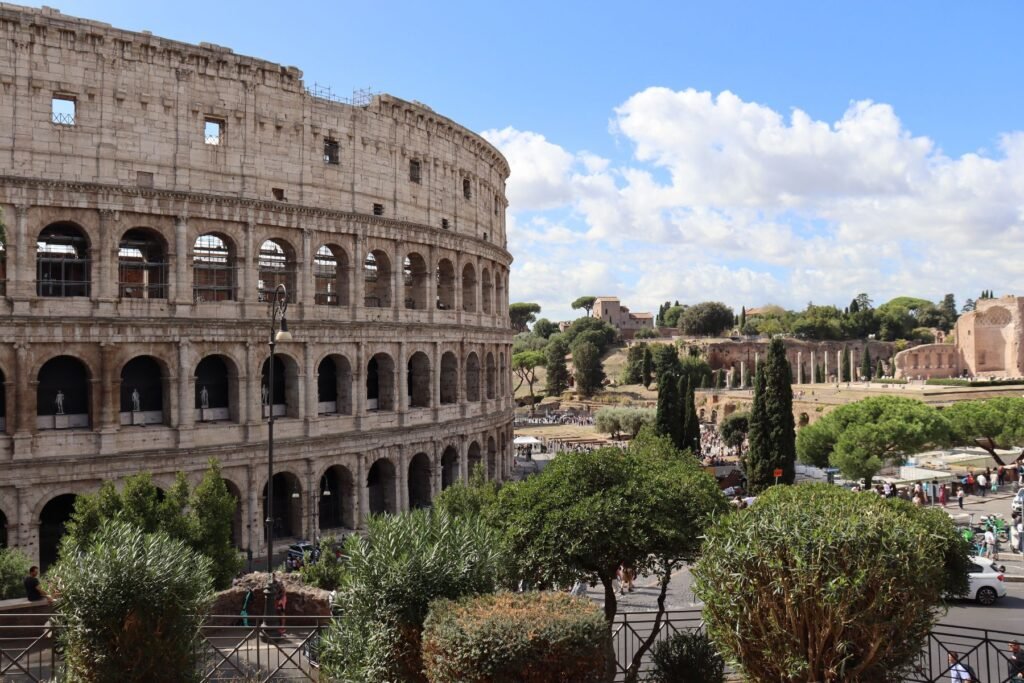
For your visit, I really recommend booking a skip-the-line ticket or guided tour in advance.
The line to enter can be long, especially in the peak summer season, and trust me, with only 48 hours in Rome, we don’t have time to be standing around in queues!
Inside, you’ll get a real sense of the sheer scale of it all, especially when you stand at the top and look down over the arena.
And if you’re into history, the exhibits are fascinating too, showing you artefacts and sharing information about the gladiators and animals that fought in this arena.
Your visit to the Colosseum should take between 1-2 hours, depending on how much time you want to dedicate to exploring the exhibits and listening to the audio guide.
You can book your tickets here. Or a local-led guided tour here.
Katie’s Top Tip: Book a ticket that includes the arena floor (you can book that here). Visitors to the arena floor are limited and staggered, so it allows you to enjoy the Colosseum and take photos without the crowds. Plus, from this angle you get a sense of just how imposing the arena actually is!
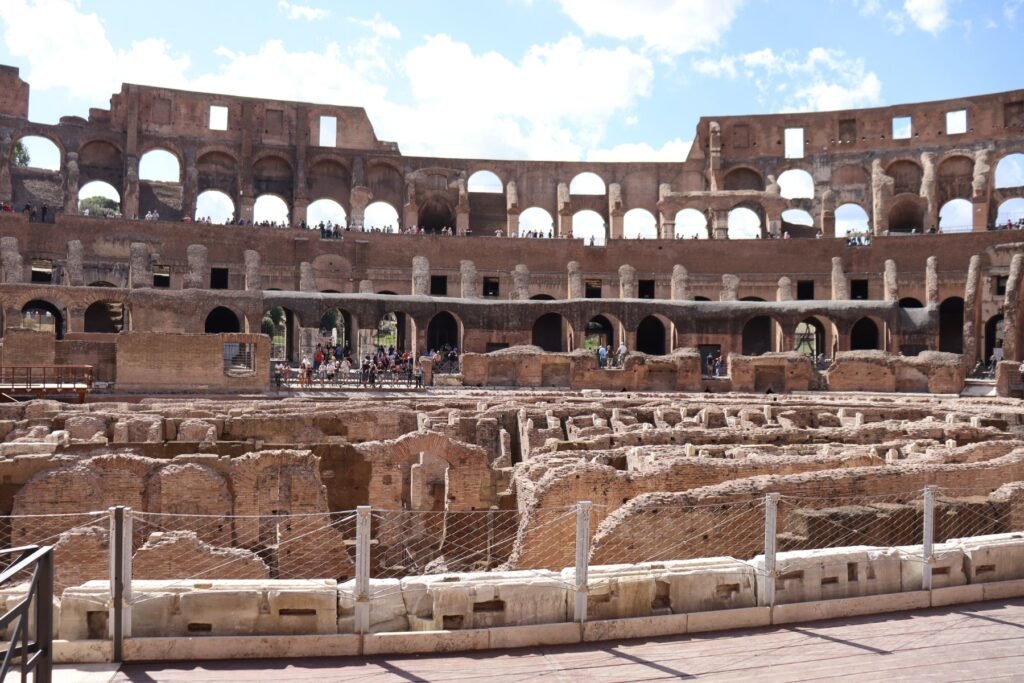
Optional: Morning Walking Tour Near the Colosseum
If you’ve finished exploring the Colosseum, follow this easy 40 minute walking route to see some of the best sites Rome’s city centre has to offer:
- Don’t forget to spend some time enjoying the exterior of the Colosseum. It’s just as impressive (maybe more so!) from the outside, especially with fewer crowds.
- See the Arch of Constantine, a triumphal arch built in 315 AD. (You can’t miss it, it’s right next to the Colosseum!)
- Visit Campidoglio Square, a stunning Michelangelo-designed plaza with beautiful views over the Roman Forum.
- Stroll down to Piazza Venezia and admire the massive white monument known as the Altar of the Fatherland.
- Continue your walk to Piazza Navona, one of Rome’s loveliest squares. It’s the perfect spot to grab a coffee or just people-watch from a bench!
- Admire the Pantheon, a 2nd century ancient temple, with a truly breath-taking grand rotunda to admire!
- Don’t forget to make time for a leisurely lunch!
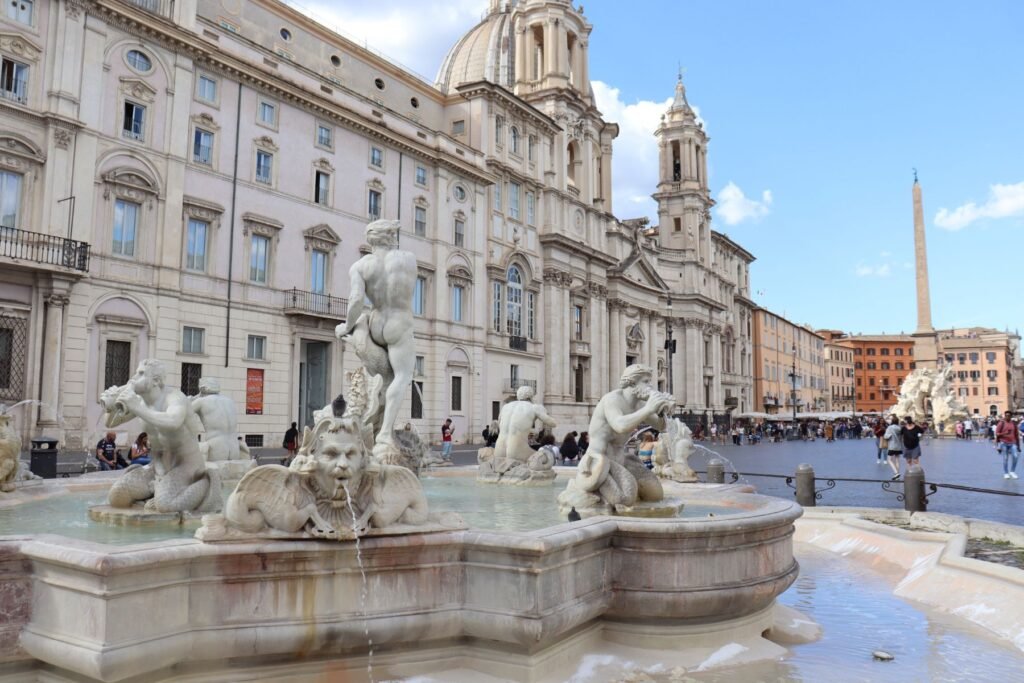
The entire walk takes around 40 minutes – although you will definitely want to factor in extra time for sitting and people watching, taking photos, enjoying lunch and also entering the Pantheon, if you wish.
I definitely recommend visiting inside the Pantheon if you have time.
The dome is still the largest unreinforced concrete dome in the world, and when you stand directly under the oculus (the open hole at the top), it feels both grand and peaceful.
Plus, the light shifts constantly inside the Pantheon, so if you can catch it when a beam is falling straight through the oculus, it’s magical!
You can find my exact Rome walking tour route map here.
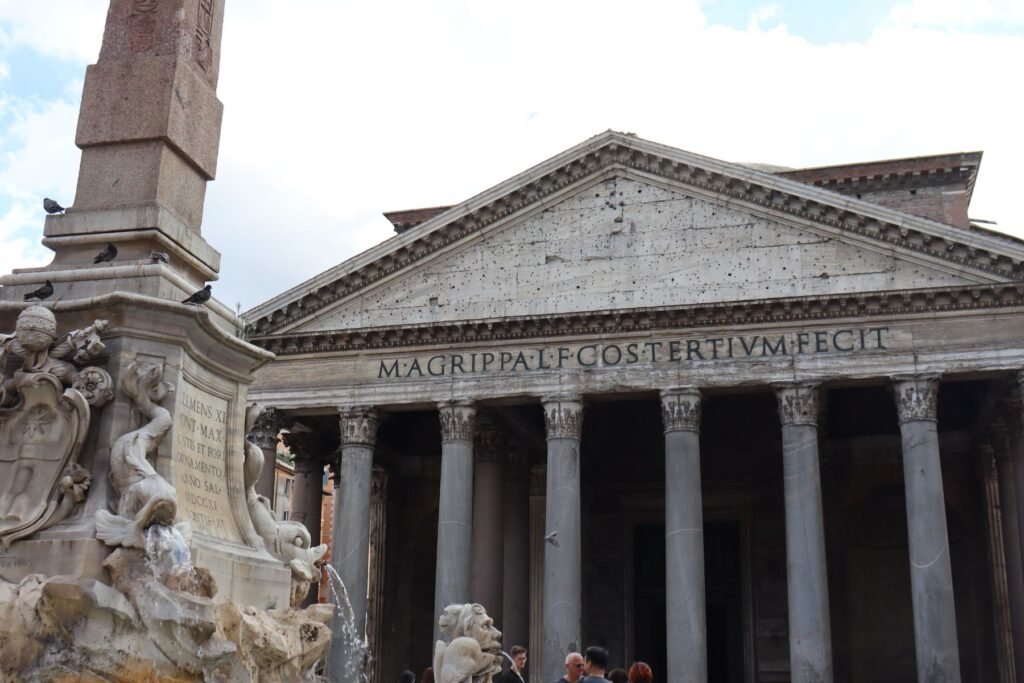
Afternoon: Roman Forum
If you know anything about Rome’s geography, you may (rightly) be wondering why I chose to leave the Roman Forum until the afternoon for this itinerary.
(After all, if you choose to follow my walking route after your visit to the Colosseum, there is a short time of retracting your steps).
However, I have found that the Roman Forum is much quieter and so much more enjoyable to visit if you go after lunch. 3pm onwards begins to get quieter, while after 5pm is the sweet spot.
Your visit to the Roman Forum is included in the ticket you used to enter the Colosseum.
And while you can technically see all that the Forum has to offer in around one hour, I would recommend taking your time here.
The Forum feels like a rare place of calm in the busy city, and after a full morning of walking it’s nice to take your time. There are plenty of places to sit and admire the ruins, and on previous visits I have spent up to three hours taking it all in!
The Forum truly is my favourite place in all of Rome, but this is a sightseeing guide, after all.
So what is there to see and do at The Forum that warrants such a large part of your 48 hours in Rome itinerary?
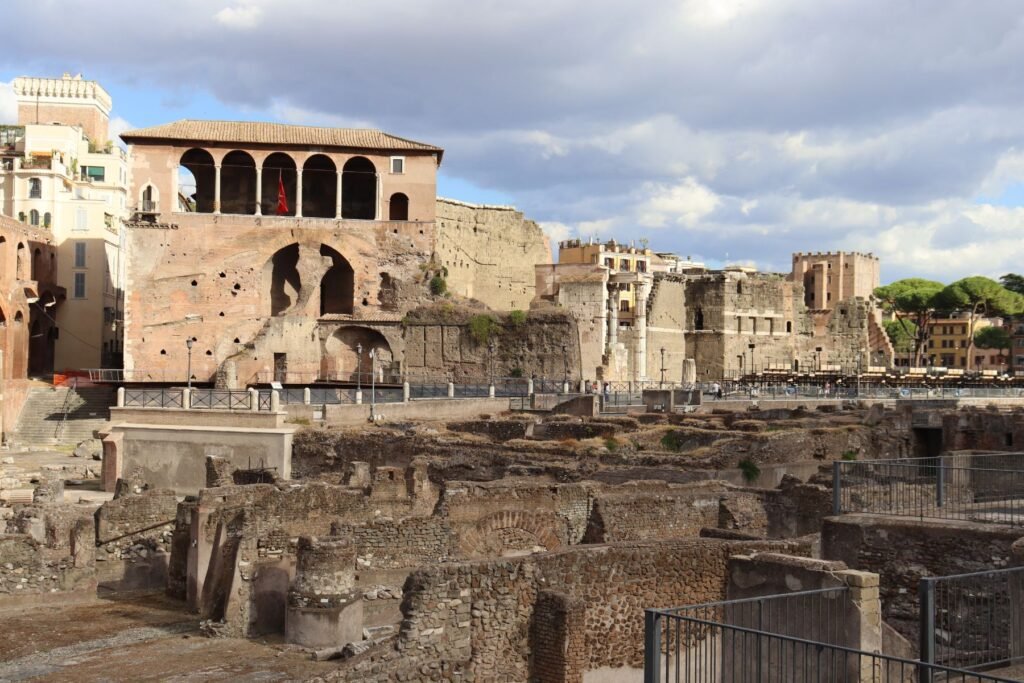
Top 10 Things To See in The Roman Forum
The Roman Forum is absolutely packed with ruins, but these are the spots I recommend focusing on if you want the most interesting, beautiful and photo-worthy highlights:
- The Arch of Titus – A striking triumphal arch marking the entrance to the Forum. Look up at the carvings celebrating the Roman victory over Jerusalem.
- Via Sacra – The ancient “Sacred Way” is one of the oldest streets in the entire city, dating back to the 6th Century BC. I love to imagine the centuries of people those stones have carried!
- The Temple of Divus Romulus – A small but beautifully preserved circular temple with its original bronze doors still in place.
- Roman Forum Square – As the heart of the ancient city of Rome, this was where Romans gathered for speeches, trials and everyday life.
- Arch of Septimius Severus – Another majestic arch from 203 AD, celebrating a military victory in Parthia.
- The Temple of Antoninus and Faustina – A grand temple turned church, with towering, majestic columns to admire.
- House of the Vestals – Once home to the priestesses who kept Rome’s sacred eternal flame burning. You’ll find peaceful gardens and intricate statues here.
- Temple of Vesta – Just beside the house, this round temple once held the sacred flame. It may be small but it’s very historically important!
- Farnese Gardens – A quiet, leafy spot on Palatine Hill with lovely views and shady benches, perfect for a relaxing break!
- Palatine Hill – Don’t miss the truly stunning panoramic view over the Forum and Rome from the top.
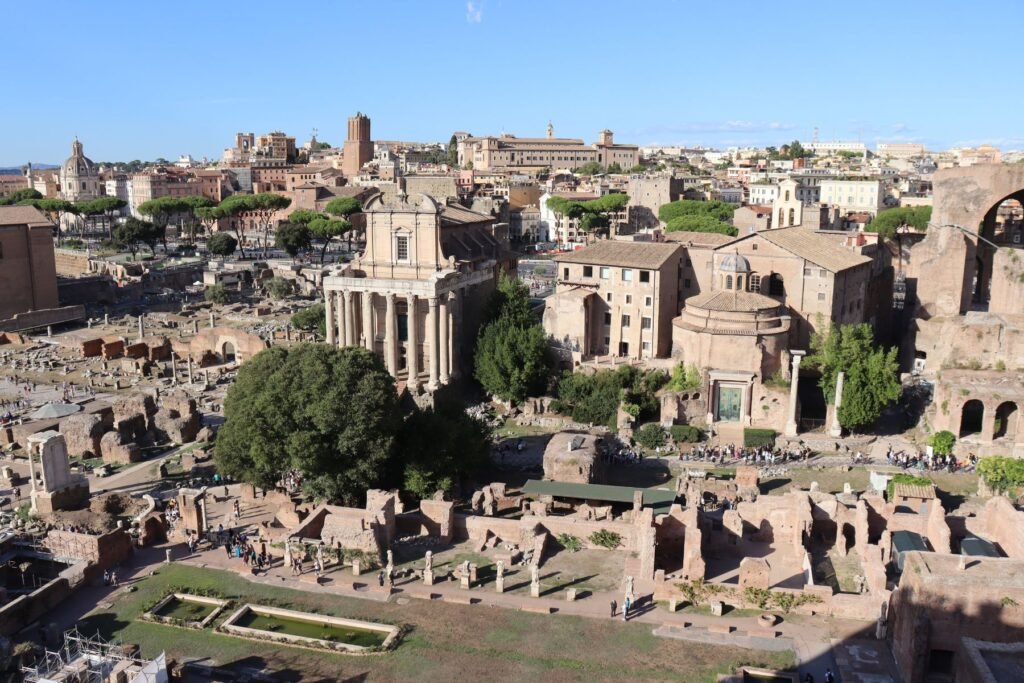
Palatine Hill
Palatine Hill gets an extra special mention here (and is well worth the climb), because of its stunning view across Rome. As you make your way up the hill, you can see the Colosseum and the buildings of the Forum stretching out at your feet. It is truly magical!
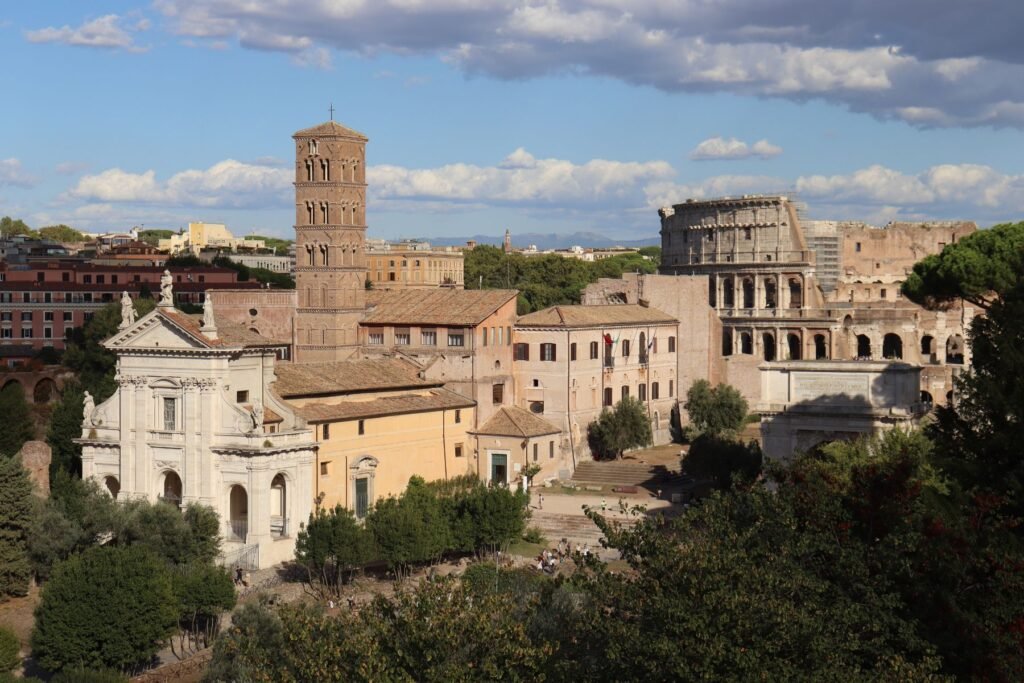
Evening: Dinner & Gelato
Allow yourself sometime to get lost and see what you discover, especially in the areas surrounding the main squares of Navona and Campidoglio.
I always find that the very best memories are created when I am not looking for them and, even as a solo female traveller, I like to enjoy the early evening in a city (while taking proper safety precautions, of course – more on that later).
Take the opportunity to slow down, wander where your feet take you and, of course, find a good spot for dinner and/or gelato!
Day 2 – Art & Soul in Vatican City
Day two is where the heart and soul of your 48 hours in Rome kicks in, and we head to Vatican City.
Today, it’s not just about seeing, but about feeling Rome and, even if you’re not religious, you can’t help but be moved by the Vatican and just how much this place clearly means to so many Catholics around the world.
Morning: Trevi Fountain, Spanish Steps & Vatican City
Wake up early on day two and head to the Trevi Fountain and Spanish Steps before it gets too crowded.
I arrived at the Trevi Fountain at around 7am and the Spanish Steps at around 7:30am.
There were still plenty of people around, but it was a much quieter experience than if you go later in the day.
If you picked one of my recommended hotels, you’ll be staying within walking distance of these iconic sites. But if you’re staying elsewhere, you’ll need to get bus 62 or metro line A.
There’s something undeniably magical about the Trevi Fountain (despite it being very touristy!)
Local legend here also says if you toss a coin over your left shoulder with your right hand, it guarantees a return to Rome. So make sure you bring a coin if you want to join in with this fun local belief!
The Trevi Fountain is a classic Rome tourist attraction for a reason and shouldn’t be missed during your 48 hours in Rome!
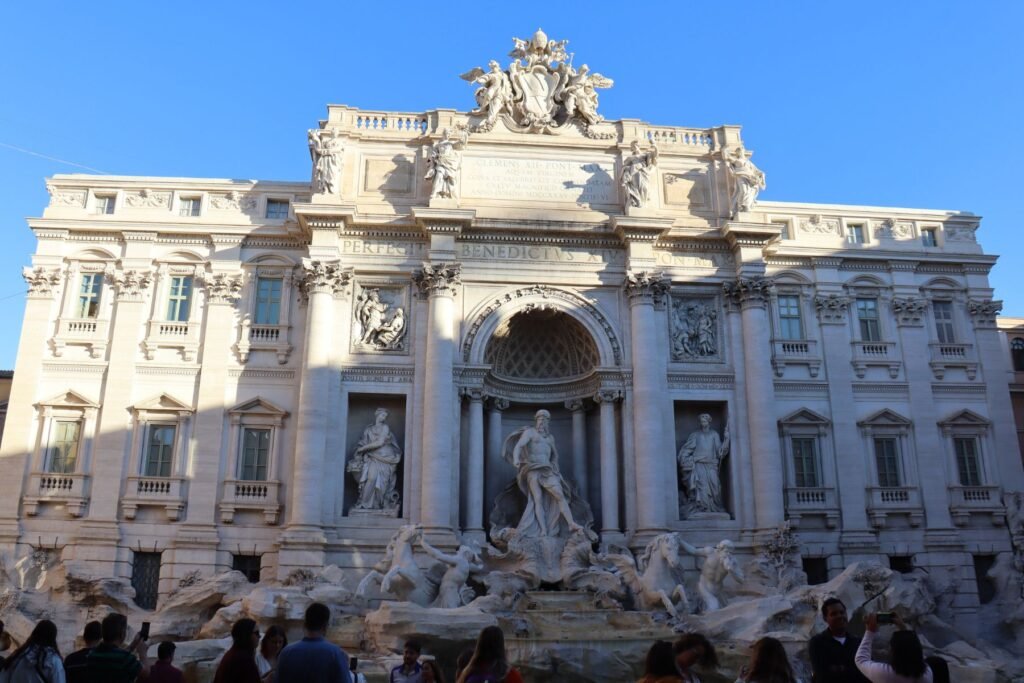
Once you’ve finished admiring the Trevi Fountain, walk 10 minutes to the (equally famous) Spanish Steps.
The wide, grand staircase connects Piazza di Spagna below with the Trinita dei Monti church above, and the whole area buzzes with life, even early in the morning!
You’re not supposed to sit on the steps these days (it’s a local law), but it’s still a lovely place to pause in the early morning and snap a few photos, of both the steps themselves and the iconic view from the top.
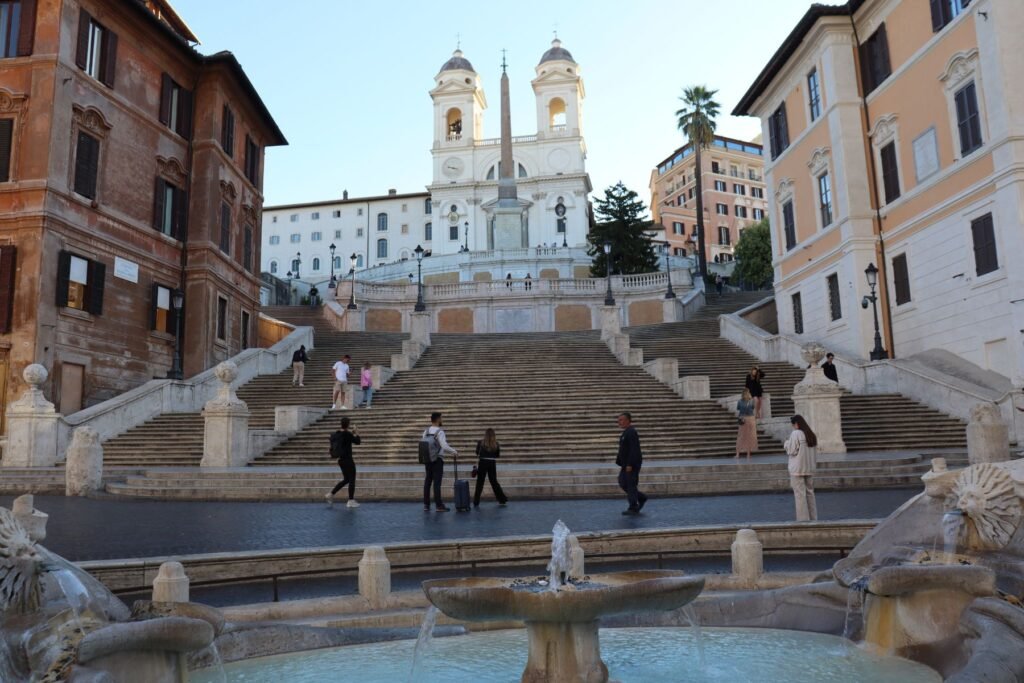
I visited both the Trevi Fountain and the Spanish Steps and then walked all the way to Vatican City (taking around 50 minutes total).
The walk is beautiful, taking you through small streets, crossing the Ponte Cavour bridge and passing Castel Sant Angelo.
But if you want to save your energy for the Vatican Museums, you can also hop back on the bus or metro at the Spanish Steps.
I crossed the border into Vatican City (which is its own country!) at around 9am and it was still quiet enough that it didn’t spoil my enjoyment of the place or the atmosphere.

Spending some time in Vatican City, you could:
- Enter St Peter’s Church (Free to enter. I would recommend doing this as soon as you arrive in Vatican City to avoid the queues that form later in the day).
- Send postcards to loved ones from the Vatican Post Office
- Admire Piazza San Pietro (St Peter’s Square)
I spent just over one hour in total admiring the external façade and square of Vatican City, writing and sending postcards, and entering St Peter’s Church.

Afternoon: Vatican Museums, Sistine Chapel & Gardens
Depending on how long you choose to spend exploring the exterior attractions of Vatican City and whether you decide to get lunch before or after entering the Vatican Museums, you will find yourself arriving at the Vatican Museums in the late morning or early afternoon.
This is seen to be peak time, however if you book a ticket that includes skip the line (highly recommended), you will be guided through security quickly and efficiently.
I did this in late September at around 11am and there was no wait.
I started off by visiting a few of the smaller exhibitions before tackling the main museums.
My favourite of these exhibitions was the one displaying past and current Papal vehicles.
Visiting the smaller exhibitions and taking photos in the beautiful Vatican Gardens took just under an hour.
If you opted not to have lunch before entering the Vatican, I would recommend heading to the Vatican cafeteria next, for an early lunch before a full afternoon exploring the museums and famous Sistine Chapel.
The food in the cafeteria is basic and quite expensive, but nice and filling ahead of an afternoon’s exploring.
When I last visited, you could get a meal deal of pasta, bread, fruit and a drink for 14 euros.
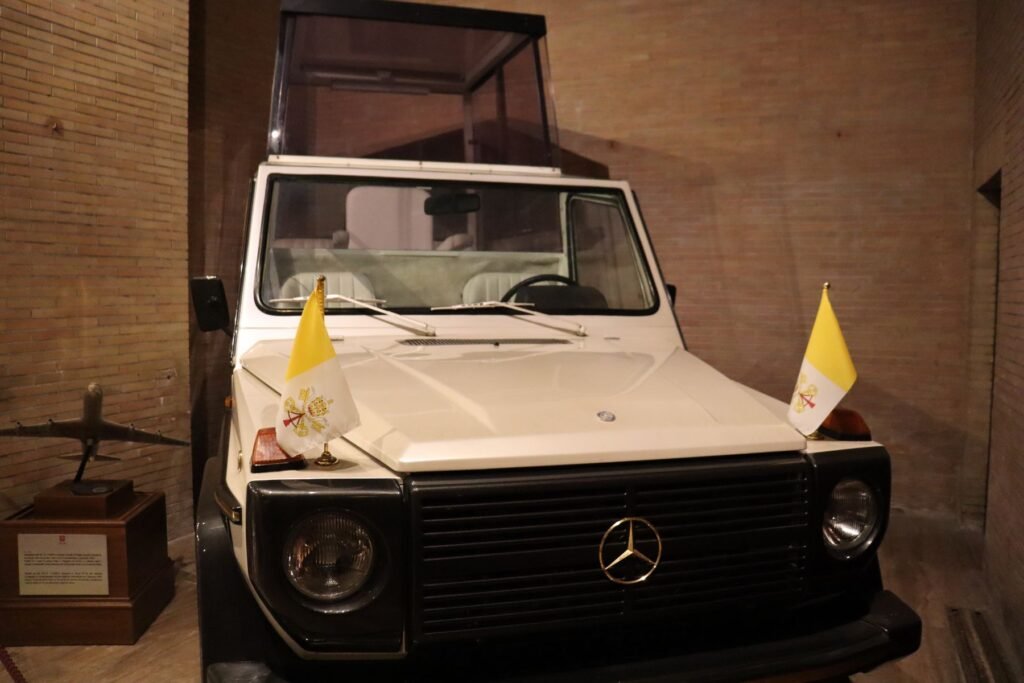
The Vatican Museums and Sistine Chapel
The Vatican Museums are vast and packed with art, artefacts and history (be prepared for a lot of walking!)
You can choose to see as much or as little of the museums as you would like, with the help of the provided map that they give you when you pass security.
Of course, the one part of the Vatican Museums everyone wants to see is the Sistine Chapel.
It is undoubtably stunning and one of a kind, but expect it to always be busy.
You will also hear the regular calls of “shh, no photos!” from security (which all of the tourists around you will then ignore!), which somewhat spoils the atmosphere.
But having said that, it is a truly iconic chapel and is well worth a visit. And for many, it is often the highlight of people’s visits to Vatican City.
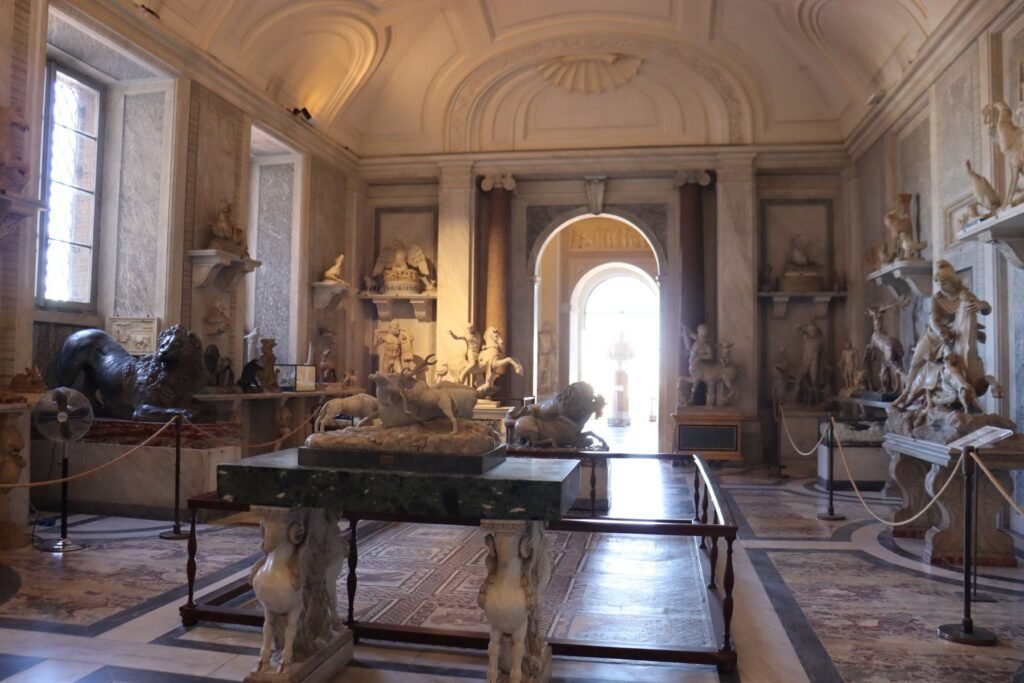
The Vatican Gardens
My highlight of Vatican City, however, are the peaceful Vatican gardens.
Only a small courtyard area is available without a separate tour, but the space is serene and feels peaceful (even when there are hundreds of tourists milling about!)
Grab a spot on one of the benches, rest your feet and spend some time people-watching and admiring the external architecture of the Vatican.
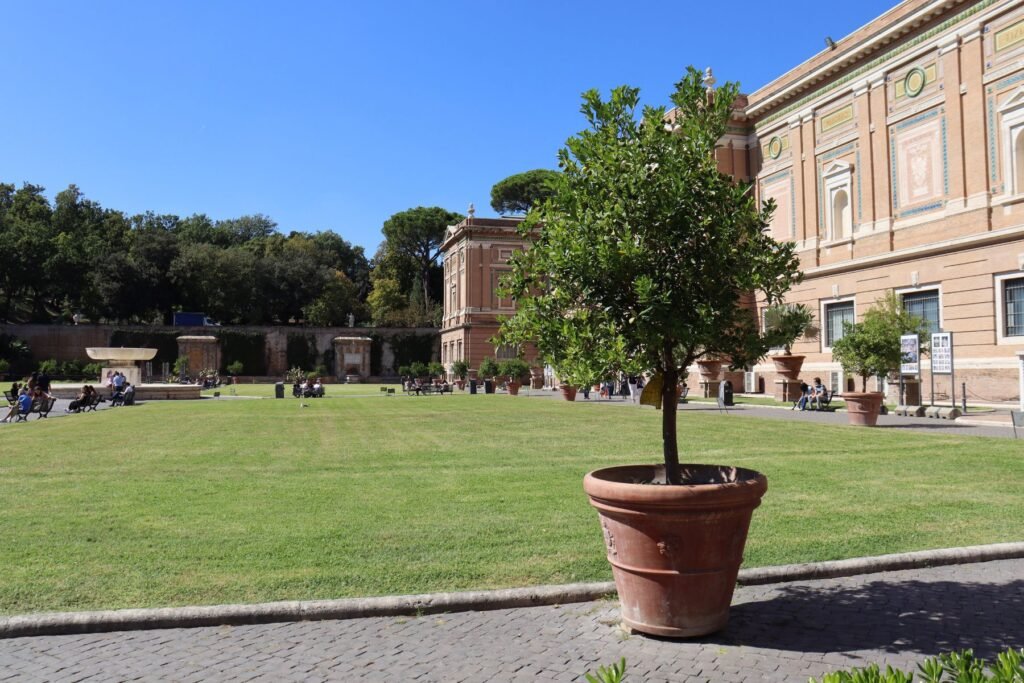
Evening: Walk Through Trastevere
On my way back from Vatican City, I decided to walk back through the Trastevere neighbourhood on the way back to my hotel.
The walk was stunning and Trastevere has a real local vibe, but by that point my feet were killing me. (For reference, this entire day of walking took 25,000 steps!)
If you’re not in the mood for that, simply get on bus 64 or the metro from either Ottaviano or Cipro-Musei Vaticani back to your hotel.
Katie’s Top Tip: Visit the Vatican early or late, and don’t skip Trastevere for real local energy and soul!
48 Hours in Rome FAQs
Safety Tips for Enjoying Rome Solo
So that’s it for our 48 hours in Rome!
I truly hope that you enjoy following this itinerary as much as I did – taking in the very best this beautiful city has to offer.
But that’s not quite it for this guide.
As a solo female traveller, I am very aware of safety whenever I visit a city – particularly whenever I visit a new city.
So here are my thoughts on safety for solo female travellers in Rome:
My Rome Solo Travel Safety Score: 8.5/10
I felt very safe in Rome, even as a woman travelling on her own.
I explored touristy areas but I also allowed myself to get lost in the side streets and never experienced discomfort or harassment.
My personal choice when I’m travelling is that I don’t like to go out late at night, but walking around in the early evening after a day of exploring didn’t feel much different to walking during the day.
Here are a few things I would note:
Not all restaurants are kind to solo travellers – I had a few experiences where I was turned away quite rudely, but please don’t take it to heart if that happens to you. It can feel upsetting but I promise there are plenty of people and places in this city who are super welcoming!
Avoid deserted streets late at night – Try to stick to popular spots and neighbourhoods in the evenings, and always let someone you trust know where you are.
Keep your belongings safe with a zipped, crossbody bag – The most common threat to tourists in Rome, as is the case in any big city, is from pickpockets and street scams. So make sure you keep your valuables in a zipped crossbody in front of you and don’t store any valuables on your back or sides. Also, don’t engage with anyone who approaches you on the street trying to sell or offer something.
Stay vigilant in crowds – This itinerary was designed to keep you away from the peak crowds as much as possible, but in Rome encountering busyness is inevitable. Keep hold of your bag in crowds and stay extra vigilant to your surroundings. If in doubt, keep walking and come back later – 48 hours in Rome may be short, but you do have time!
Katie’s Top Tip: Confidence is your best accessory when it comes to solo female travel safety. Walk like you belong here, because you do!
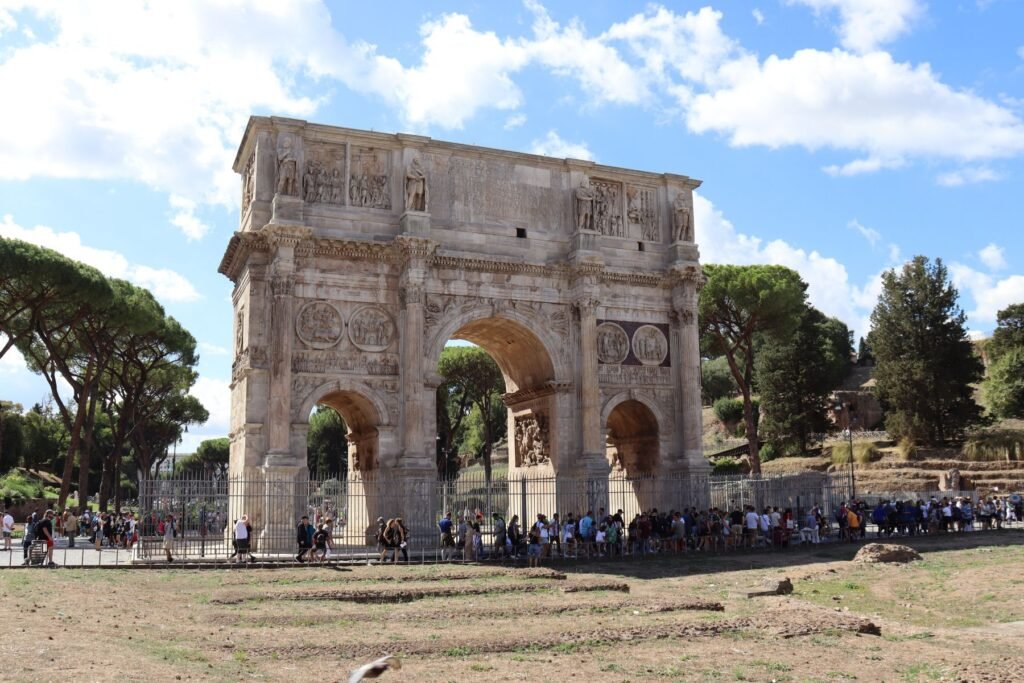
When is The Best Time to Visit Rome?
Rome is one of the most popular cities for tourists in Europe, attracting millions of visitors every year, so you should expect it to always be busy – at least to a certain extent.
The best time to visit Rome is therefore in the city’s shoulder season, between October and March, where the city is both less crowded and less expensive (win win!)
But it is also important to know that not every month included in the shoulder season is created equal.
If you don’t mind cooler temperatures and potentially overcast or rainy conditions, you will find the fewest tourists and cheapest prices during the months of November, January and February.
However, if good weather is important to you, you would be better off visiting the city during the more popular shoulder season months of October or March, or even April.
Edit: I most recently visited Rome in late September and found that the crowds were nowhere near as bad as I expected and I also found that hotel prices were already comparable to the shoulder month pricing.
Katie’s Top Tip: If quiet(er!) is the vibe you’re after for your 48 hours in Rome, make sure you avoid the time period around Holy Week, as this is when pilgrims and tourists alike flock to Rome and Vatican City to celebrate Easter.
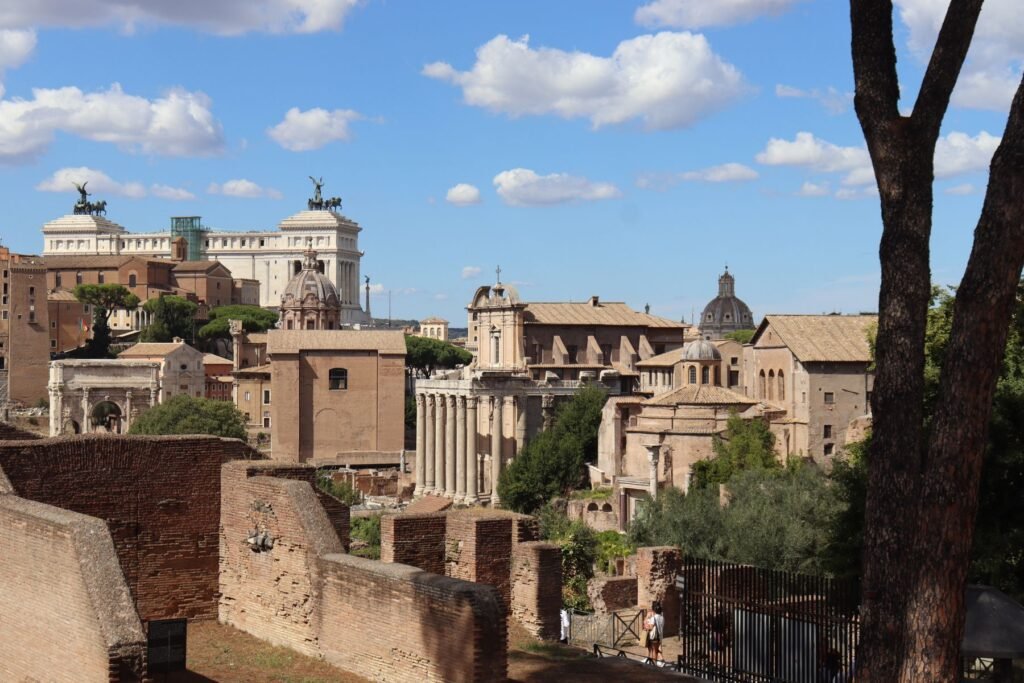
Where to Stay for 48 Hours in Rome
Where you choose to stay will always shape how you experience a city – especially when you’re looking to make the most of a short visit.
For 48 hours in Rome, I would recommend staying in the Centro Storico (or historic centre).
It felt very safe for me as a solo female traveller, it has great public transport links to (or is easily walkable to), Rome’s Termini train station, and it’s very close to top attractions like the Colosseum, the Roman Forum, the Pantheon, the Trevi Fountain and more.
Where I Stayed in Rome:
I am a no-frills hotel kind of traveller (I’d rather spend my money on unforgettable experiences and good food, rather than a room I only sleep in!)
If that sounds like you too, then Hotel Ferraro is perfect for a 48 hour stay in Rome.
It offers a private bedroom and bathroom, free WIFI, free tea/coffee, air con and an Italian breakfast brought to your room each morning. And while the room is certainly basic, it was comfortable and cleaned to a high standard.
However, what I loved most about Hotel Ferraro during my 48 hours in Rome was the location.
The hotel can be found in the historic centre of Rome, in the Monti District. It is just 5 minutes’ walk from the Colosseum and 15 minutes from Rome Termini station.
Other Rome Hotel Recommendations:
- Hotel Romano (€)
- Princeps Boutique Hotel (€€)
- The Hive Hotel (€€)
- iFlat apartment with unforgettable Colosseum view (€€€)
- Roma Luxus Hotel (€€€)
Katie’s Top Tip: If possible, stay near a piazza with lots of cafes. Early morning people-watching is pure magic in Rome!
How to Get Around Rome in 48 Hours Without Stress
Walking in Rome
Rome is a very walkable city (although it is also a very big city, so make sure to bring comfortable walking shoes!)
For my last trip to Rome, I challenged myself to not use any public transport for the entire 48 hour trip – and I did manage it, just with an average of 23,000 steps per day!
Walking the streets of Rome allows you to deliberately get lost – wander down that tiny side street, stumble across a hidden gem you wouldn’t have otherwise found, find a courtyard restaurant that is both quiet and has delicious food…
A lot of my all time favourite moments in Rome have come from those times of unplanned, unguided city walking.
I will include my full Rome walking itinerary (with a map), as part of this 48 hours in Rome itinerary, so you can decide for yourself whether you want to walk this route or opt for one of the public transport options below.
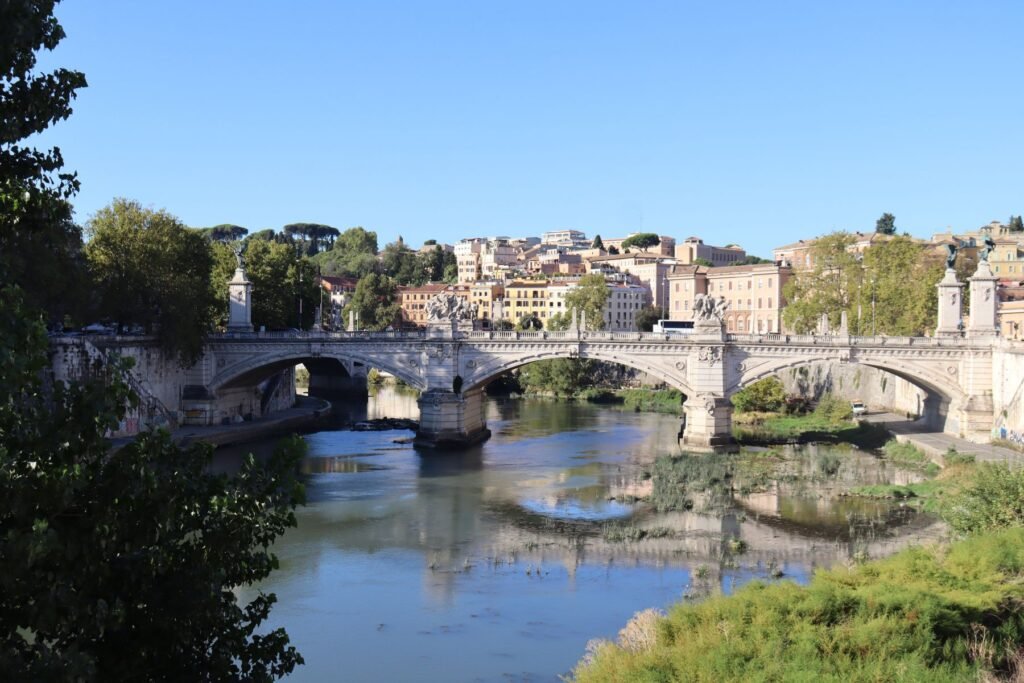
Taking the Bus or Tram in Rome
For bus travel in Rome, you have two options: the regular public bus service and the tourist hop on hop off bus service.
The regular public bus service is the cheapest of the two options, and tickets can be used together with the city’s metro service.
However, the bus system is notoriously unreliable, particularly during peak times.
The main bus or tram routes you should know are bus 60 or 75 for the Colosseum, bus 62 for the Spanish Steps, bus 64 for the Vatican, and tram 8 for Trastevere.
You can buy bus and tram tickets from ticket machines at the station or from newspaper stands.
The open top, hop on hop off bus service I recommend in Rome is Big Bus.
There is pre-recorded commentary in seven languages and the bus stops at all of the major tourist attractions in the city with its two routes – red and purple.
The red route serves key stops such as the Colosseum, Vatican and Spanish Steps, with the full tour lasting just under two hours, depending on traffic.
The purple route serves less well-known stops such as the Catacombs of San Sebastian and Circo Massimo, and the full tour lasts 1 hour 30 minutes.
Tickets can be purchased online or from official street vendors, and up to date pricing can be found here.
Katie’s Top Tip: If you are taking public transport, do not forget to validate your ticket in the machines onboard the bus or tram to avoid a fine.
Taking the Metro in Rome
The metro in Rome is more reliable and is comprised of three lines – A, B and C – connecting the major tourist locations in the city. All three of the metro lines meet at Rome’s Termini train station.
Here is the line you will need for some popular Rome tourist attractions:
- To get to the Spanish Steps, you will need to take line A (orange) to Spagna metro station.
- To get to the Trevi Fountain, you will need to take line A (orange) to Barberini metro station and then walk approximately 8 minutes.
- To get to the Vatican, you will need to take line A (orange) to either Ottaviano or Cipro-Musei Vaticani metro station. Both of these stations are around a 10 minute walk from the Vatican.
- To get to the Colosseum and Roman Forum, you will need to take line B (blue) to Colosseo metro station.
- Line C is less popular with tourists, servicing mainly residential areas, although it does offer connections with Rome’s Fiumicino Airport.
Metro tickets can be purchased for single journeys (up to 100 minutes), 24 hours, 48 hours, 72 hours, 1 week or 1 month. Up to date prices for each ticket type can be found here.
You can buy metro tickets from ticket machines at the station, from newspaper stands or tobacconists, on the TicketAppy or DropTicket apps, or use a contactless card to tap in and out.
Katie’s Top Tip: If you already have the Roma Pass for your trip, you will have unlimited travel for 48 or 72 hours already included.
Taxis in Rome
Taxis in Rome have a reputation for being expensive and for some drivers overcharging tourists for journeys.
As a solo female traveller, I always try to rely on public transport (unless I’m travelling at night), both because that makes me personally feel more secure and also from a cost point of view.
But if you do wish to get a taxi in the city, make sure you use a reputable company like Radio Taxi or Pronto Taxi.
Airport Transport in Rome
To get to and from Rome Fiumicino airport, you have a number of different options. I have ranked them here based on what I recommend:
Leonardo Express Train: If you don’t have a lot of luggage and your accommodation is within walking distance of the Termini train station, this is the quickest way to get to the city centre, taking just 32 minutes. In arrivals, this train is clearly signposted ‘Treni.’ This train currently costs 14 euros and you can buy tickets for this service at the ticket machines in the airport or on Omio.
Regional Train: This service is cheaper than the express train – costing just 8 euros. It is also a lot slower than the express service, but is ideal if you are staying near Ostiense, Tiburtina or Trastevere.
Rome Airport Shuttle Bus: The official airport shuttle bus costs 7 euros per adult and departs every 30/40 minutes. The journey takes between 45 minutes and an hour (depending on traffic), and stops at both Rome’s Termini station and near the Vatican.
Private Transfer: When you book a private transfer, a greeter will meet you in arrivals and carry your luggage to the waiting car to take you directly to your accommodation. It is arguably the easiest way to reach the city from the airport. The journey will take between 30/40 minutes depending on traffic.
Uber: Rome has access to Uber for private rides booked via their app. The journey will take between 30/40 minutes, depending on traffic.
Taxi: If you choose to get a taxi into Rome, it is important that you are aware that the journey will always cost €50 for up to four travellers and luggage. The journey will take between 30/40 minutes depending on traffic.
Local Bus: This is the cheapest option but I cannot recommend this method as it takes the longest time and there is no space on the bus for luggage.
Navigating Rome’s Termini Station
If you are visiting Rome as part of a wider European trip, or you want to extend your stay here to include some day trips, chances are you’ll need to use Rome’s Termini station. The station offers access to both national and international journeys, including:
National
- Florence
- Naples (and Pompeii)
- Milan
- Bari (Puglia)
- Venice
- Verona
International
- Vienna, Austria
- Zurich, Switzerland
- Stuttgart, Germany
- Paris, France
- Ljubljana, Slovenia
Top Rome Tours
If you truly want to make the most of your 48 hours in Rome, I would recommend booking at least one tour with a local.
There are lots of options to suit every budget and group size preference on GetYourGuide, and these local experiences cover the entire city – from well known attractions to hidden gems.
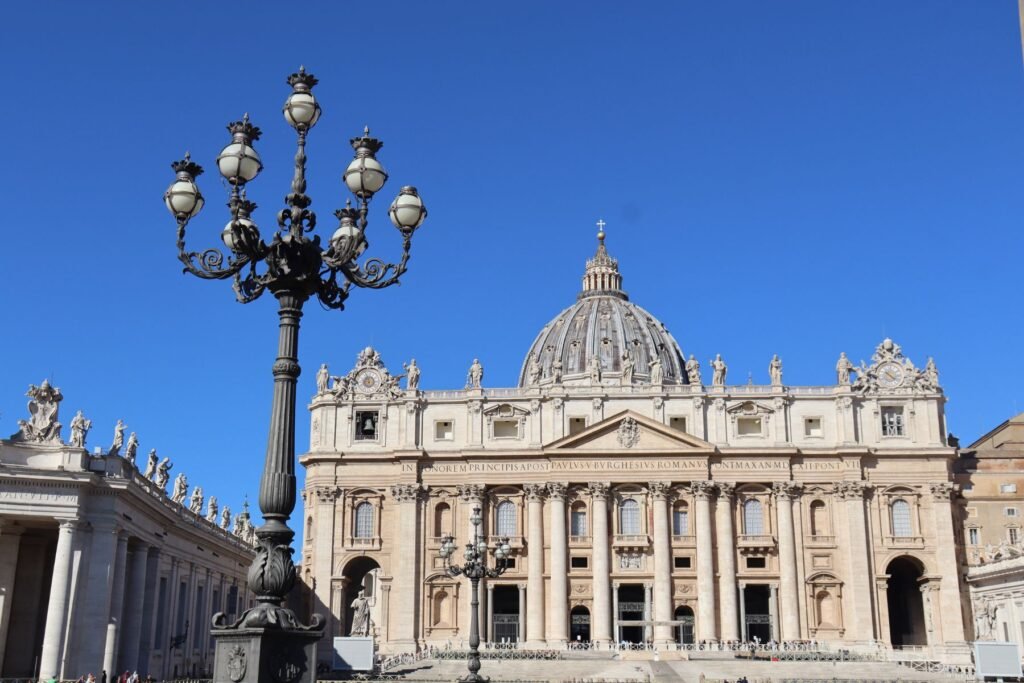
Here are some top Rome guided tours I would recommend:
Colosseum, Roman Forum & Palatine Guided Tour
Lasting between 1.5-2.5 hours, this local-led, small group tour hits up three major tourist attractions, allowing you to get a glimpse of iconic Rome in a short amount of time. Priority access and all entry tickets are included.
Early Entry to Museums, Sistine Chapel & St Peter’s
If you want to explore the Vatican without the crowds, join this 3.5 hour guided small group tour. It guarantees you the earliest entrance slot and saves you from getting lost in the many corridors of the Vatican Museums. Plus, you benefit from the knowledge of a passionate local guide!
Trastevere & Campo de Fiori Street Food Walking Tour
For my foodies, this 2.5 hour top rated walking tour combines culture with delicious local dishes. The small group tour includes street food tastings and a guided tour of the less-visited Trastevere neighbourhood, for a truly unique and authentic Rome experience.
Have a little longer than 48 hours in Rome?
Explore more of Italy with this Pompeii, Amalfi Coast, and Sorrento day trip!
This full day tour lasts between 12 and 13 hours and covers the very best highlights of the Italian coast, including the spectacular archaeological site Pompeii and the stunning coastal town of Sorrento. Skip-the-line access, guided tours and free time are all included in this jam-packed day excursion.
Final Thoughts: You’ll Never Forget These 48 Hours in Rome, Italy
Rome has a way of staying with you, long after you’ve left it, and the real magic of Rome lies in how it makes you feel.
So if you’re still wondering whether 48 hours in Rome is enough, know that it absolutely can be…
Not to see it all, but to truly experience the city as it is meant to be experienced!
This 48 hours in Rome itinerary wasn’t about checking things off a bucket list or racing from landmark to landmark.
Instead, it was about seeing the places that will connect you to the very heart of this ancient, eternal city.
And maybe you’ll leave with a little piece of Rome embedded in your heart, ready to return and explore some more! (I know I did!)
Have you been to Rome yet? What surprised you the most about the city? Let me know in the comments!
Read More About Travel in Italy:
- Is Rome Safe For Solo Female Travellers? Rome Safety Tips
- How to Spend 48 Hours in Rome: Iconic Sights and Hidden Gems


